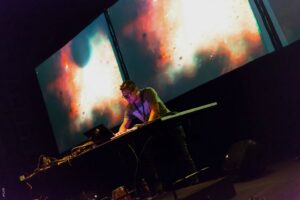NFTs
 Diego Esquivel [ctrl_v]
Diego Esquivel [ctrl_v]
Diego Esquivel aka [ctrl_v] is a New Media artist born in Costa Rica. His work has been continuously developed due to his interest in bringing the digital into the physical world, and is characterized by using non-traditional media, such as vjing (real-time visual performances involving a screen or projection), digital compositions, projection mapping, and more recently, augmented and virtual reality.
Your art is a bit different from what we’ve seen so far. To get us started, can you explain the differences between VJ (video jockeying), AR (augmented reality), AV (audiovisual) and VR (virtual reality)?

This picture was from an event called Live Performance Meeting at the National Center of Arts in Mexico City. It was an AV Performance, cause I also used audio, so I was creating an audio visual narrative in real time.
VJing usually relates to syncing visual compositions to somebody else’s music.
Virtual reality is nice in the way that it takes you to a completely different world, but you miss the contact with your surrounding.
In augmented reality you are enhancing your surroundings with your own creative flair rather than building completely new surroundings altogether. And that’s what I love about it – it adds a new layer of reality to what is already around you. For me it’s like discovering the use of perspective during the Renaissance.
I created 3 framed digital paintings in a work called “Gene.sys” which I added the AR content to them. This is how they look with augmented reality through the mobile camera:



These are amazing! Can you explain a bit how it works? What is necessary to see the art piece as augmented reality? Do you need to have a digital painting as a base first? Or is it possible to create the effect of augmented reality independently?
Either way. You can create augmented reality content independently or linked to a specific image.
From what I see, your art is a lot about immersion and experiencing multiple senses. Did you always know that you were interested in creating this kind of art? How did you get into this specific niche?
Let’s say I’m a curious artist.
The visual aspect with technology is what always has caught my attention. I think it all became very clear when I got to know the projection mapping technique, which gives you the chance to modify a real space with projected digital content:

How do you incorporate knowledge of the physical object (in this case, the building) when you create pieces like these?
First, I like to have some history background of the place , which is not mandatory for creating the content but it helps. Then, I do a scouting of the place if possible.
But the most important thing is to have a frontal reference of the structure, so you can use it as template or blueprint for creating the digital content. Usually a frontal full picture is enough

I personally find projection mapping fascinating as well. It really creates a new interaction between the art and the pre-existing space. What tools and knowledge are required for projection mapping?
And what was special about projection mapping that influenced the rest of your style?
Digital compositing tools for creating the content. I used a lot of Photoshop, After Effects and Cinema4D, but I have seen artists who use also pictures of paintings and drawings.
And very important – software for adjusting the content within the projection. The most used are Resolume Arena and Madmapper.
What I loved since the beginning that I started working with this technique, was the possibility of mixing the digital and the real worlds. Taking the digital art out of the screen.
On a side note, does your artist name [ctrl_v] have anything do to with the style of art you make?
Interesting question!
I guess it has to do with the feeling of controlling visuals, ctrl_v comes from there and the implicit use of technology in my art, so it’s sort of like a computer command too.
In your Van Gogh NFTs for The Other Avatars, the backgrounds resemble projection mapping as well. Is there an option for augmented reality in your avatar pieces?
Unfortunately not. That was the original plan but I ran out of time.
For me, it was really awesome that Saatchi decided to replace the computer algorithm that usually generates this type of NFTs, with the huge artistic human talent from around the world. I loved the process of working for this project so much I’m very honored to be part of it. Thank you for the opportunity!
Love reading about all things art? You can have articles from Canvas, curated collections, and stories about emerging artists delivered straight to your inbox. Sign up for the Saatchi Art Newsletter.





